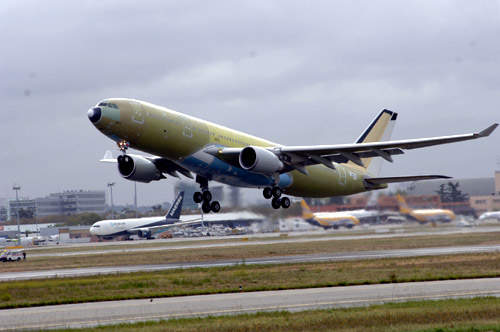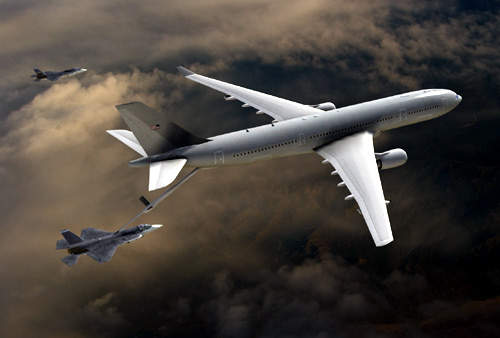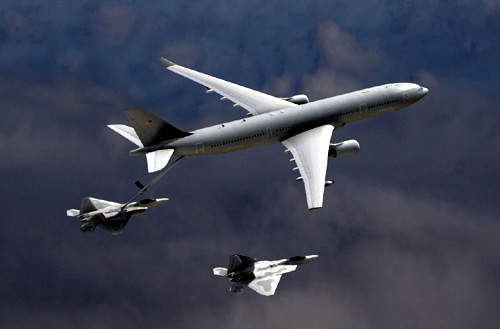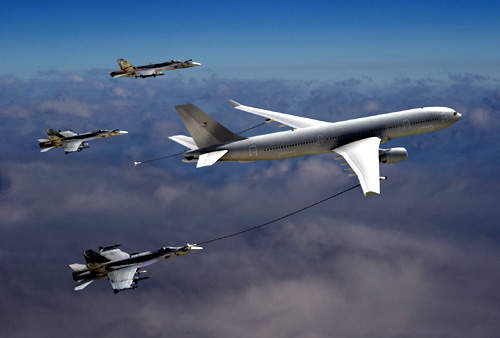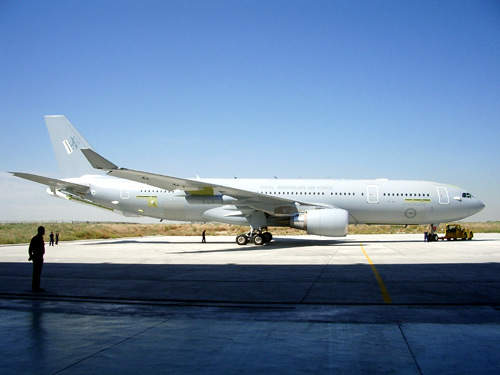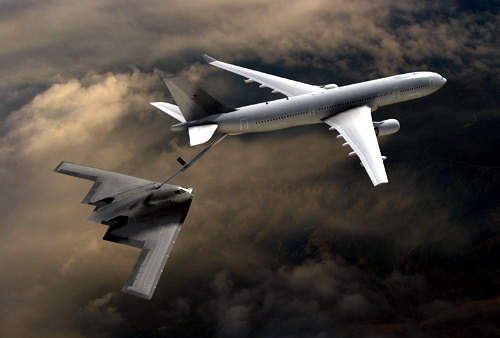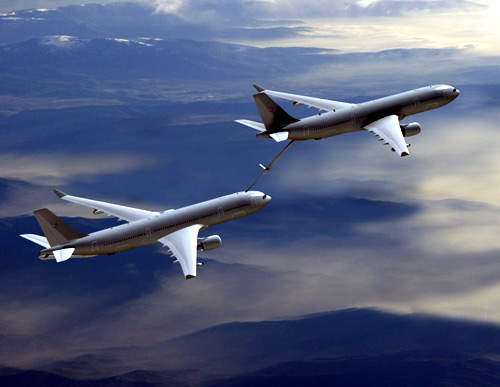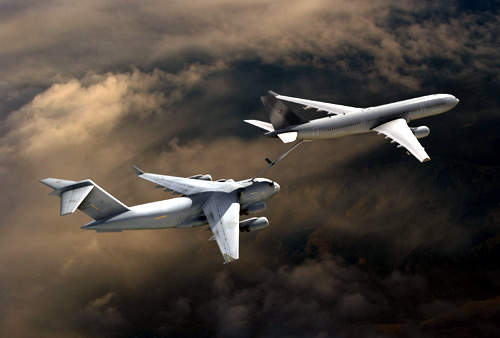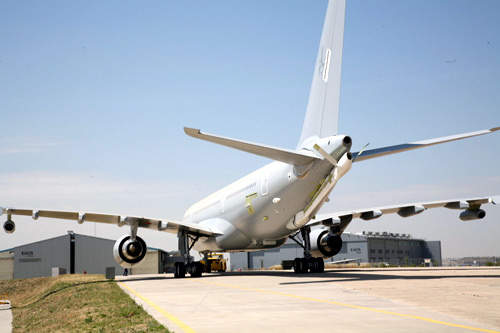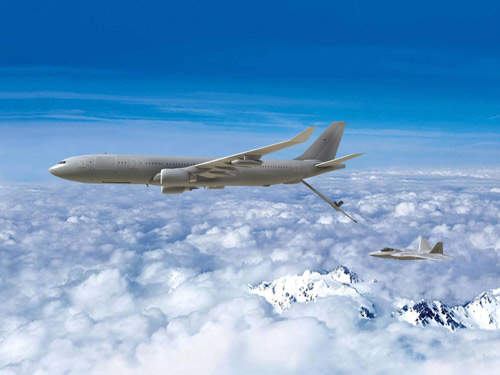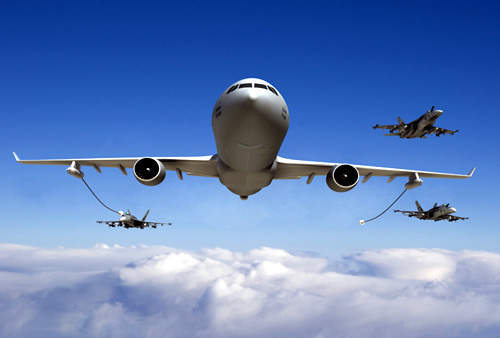The KC-45 aircraft is based on the A330 multirole tanker transport, selected by the air forces of Australia, the UK and the UAE. Mission equipment will include EADS’s fly-by-wire aerial refuelling boom system (ARBS), with two all-digital FRL 905E-series hose and drogue refuelling pods, whihc is the same configu.ration as selected by the Royal Australian Air Force.
The first KC-45 Tanker aircraft, the D-1, completed its maiden flight in September 2007. D-2 completed its first flight in May 2008. The KC-45 aircraft can deploy fully loaded from airports and airfields with a 7,000ft runway.
KC-X tanker programme
In February 2008, the US Air Force chose the KC-30, since renamed KC-45, for its KC-X tanker aircraft replacement programme, to replace its fleet of KC-135 air tanker aircraft approaching the end of their operational life.
Northrop Grumman, teamed with EADS North America, proposed the KC-45 tanker aircraft, a variant of the Airbus A330-200, for the USAF KC-X requirement. An initial contract for the first four of a 179 aircraft requirement was placed.
Boeing appealed against the award and asked the US Government Accountability Office (GAO) to review the decision in relation to the evaluation award criteria established for the competition. The GAO sustained the protest and, in June 2008, recommended that the USAF reopen the bidding process. In September 2008, the US Department of Defense cancelled the competition, citing the need to defer any decision until the next presidential administration, which gained power in January 2008.
KC-X tanker programme reopened
In September 2009, the Department of Defense and the US Air Force released a request to bid for the aerial refuelling tanker replacement programme. Northrop Grumman announced its plans to again offer the KC-45 tanker. The bid was withdrawn by Northrop Grumman in March 2010.
In February 2010, EADS North America announced its decision to compete with Boeing for the $35bn bidding process for KC-X contract. The USAF extended the previous 10 May 2010 deadline to 9 July 2010 to accommodate EADS’ bid. EADS submitted its bid to the USAF on 8 July 2010.
The EADS manufacturing team of the next generation KC-45 includes General Electric, AAR Cargo, Eaton, GKN, Goodrich, Hamilton Sundstrand, Honeywell, RTI, Vought and Cobham.Final assembly of the KC-45 was to be carried out at EADS’s Brookley Field facility in Mobile, Alabama.
In September 2010, EADS demonstrated that its new KC-45 tanker can fulfil the US Air Force specifications for high fuel flow rates. EADS carried out the demonstration through a refuelling operation between two Airbus Military A330 multirole tanker transports.
In February 2011 final bids were submitted by Boeing and EADS and on 24th February the US Airforce announced Boeing’s bid as the winner.
KC-45 airframe
EADS is responsible for providing the proven A330-200 aircraft and its fly-by-wire advanced aerial refuelling boom system (ARBS). The A330-200 aircraft has an advanced wing with optimised aerodynamics, and the airframe incorporates high-strength low-weight composite aerostructures.
Cockpit
The KC-45 has a crew of three: the pilot, co-pilot and the boom operator. The aircraft incorporates fly-by-wire technology and has cockpit commonality with the A318, A319, A320, A321 and A340 families of aircraft. The cockpit has side-stick controllers.
Smiths Aerospace, based in Grand Rapids, Michigan, was selected to provide the aircraft’s flight management system.
KC-X.”
Honeywell of Phoenix, Arizona is supplying the KC-45’s radio management system, mission avionics suite and mechanical systems, including the military airborne collision avoidance system – formation rendezvous (MILACAS-FR) system.
The communications systems division of Telephonics Corporation will supply the KC-45’s intercommunication system.
Refuelling system
The KC-45 has a maximum fuel capacity of 250,000lb, (representing 25% more fuel than the capacity of the KC-135 aircraft) and a multi-point refuelling system with a mix of boom, hose and drogue, and hose drum systems which provide flexibility, high off-load rates and servicing of more aircraft per mission, thereby reducing or eliminating queues of waiting aircraft and lowering fuel-related mission-abort rates.
The KC-45 has two under-wing refuelling pods and a centreline hose and drogue unit, which allow probe-equipped receiver aircraft from the US Navy, Marine Corps and allied forces to be refuelled.
One operating option involves the direct view of the receiver aircraft from the rear of the KC-30. The other option involves the use of a remote air refuelling operator station (RARO station) installed in the flight deck. Both the direct view option and the RARO station option are optimised in terms of the man-machine interfaces. For day and night boom operation the aircraft is fitted with a 3D stereoscopic enhanced vision system.
Sargent Fletcher, a wholly owned subsidiary of the UK company Cobham, is providing the two digital FRL 905E series hose and drogue (900 series wing pods and drogues) which will be installed on the KC-45 tanker’s outboard under-wing positions. The maximum fuel offload rate of the pods is 420gal a minute (2,800lb a minute). The system will provide full interoperability with all refuelling-capable US and Nato military aircraft.
The 900 series pods already are used on EADS A310 MRTTs for the Canadian and German Air Forces and on the US Air Force MC-130H. The under-wing refuelling pods are installed on pre-existing hardpoints already outfitted for fuel and power and therefore require no structural modifications to the wing.
The centreline hose drum refuelling unit is installed under the aft section of the fuselage, and provides an additional hose and drogue contact point with a 90ft hose length and a maximum offload refuelling rate of 4,000lb a minute.
The EADS ARBS uses the same fly-by-wire technology as the KC-45’s flight control system and includes an automatic load elevation system, an independent disconnect function, redundant actuation systems and power supply.
In July 2009, the aircraft fitted with ARBS demonstrated night-time operational capability during a multicontact mission with an F-16 fighter.
The mission demonstrated the capabilities of the ARBS’ laser infrared lighting and high-definition digital stereoscopic viewing system. The flight tests were part of the final qualification phase for the EADS A330 multirole tanker transports.
The boom is fitted with a roll and pitch joint which provides improved controllability. The maximum fuel off-load rate for the boom is 1,200gal a minute.
The boom is suitable for all current receiver aircraft and is easily adaptable for future mission requirements including the refuelling of unmanned air vehicles (UAVs). The boom’s geometric refuelling envelope is automatically configured for each type of receiver aircraft by the KC-45’s onboard intelligent control system.
In-flight refuelling of the KC-45
The KC-45 is fitted with a universal aerial refuelling receptacle slipway installation (UARRSI) supplied by Parker Aerospace, based in Irvine, California. The UARRSI is the refuelling receptacle installed on top of the KC-45 that allows it to receive fuel. This allows a tanker returning to base to off-load any excess fuel to the incoming tanker thus saving fuel and costs.
Cabin and cargo decks
The aircraft can carry up to 280 troops or passengers on the main deck and there is additional volume for equipment and material in the lower deck cargo bays.
The aircraft supports the fighter squadron’s deployment by transporting the operational personnel and equipment in addition to carrying out the refuelling escort for the squadron’s aircraft to an overseas base. This allows the fighter squadron to deploy as a unit, and then after arrival, to quickly ramp up to a combat-level sortie.
The large cabin provides volume for additional mission equipment and the onboard power supply can accommodate add-on loads such as scalable multifunction automated relay terminals (SMART).
The aircraft has the volume and power capacity to support add-on command and control, intelligence, surveillance and reconnaissance (C2ISR) systems.
The wide-bodied fuselage can accommodate a suite of intensive-care systems and 120 stretcher patients (litters) for medical evacuation missions.
A typical mixed configuration would include 70 litters, six intensive-care units and 113 medical staff and passengers on the main deck.
Cargo
The main deck can carry 280 passengers or 26 463l pallets. Loading and unloading is through a 141in x 100in cargo door. The lower deck can carry an additional six pallets. The KC-45 cargo loading system is supplied by AAR Cargo Systems which is based in Livonia, Michigan.
KC-45 engines
The USAF KC-45 aircraft is powered by two CF6-80E1A4B turbofan engines supplied by GE Aviation and rated at 72,000lb thrust. The CF-6 series already equips the EADS A330 multirole tanker transport for the Royal Australian Air Force, on which the KC-45 is based.
Performance
The maximum speed of the aircraft is 880km/h and its cruise speed is 860km/h. The range and service ceiling of the KC-45 are 12,500km and 12,500m respectively. The aircraft weighs around 120,500kg and its maximum take-off weight is 230,000kg.

